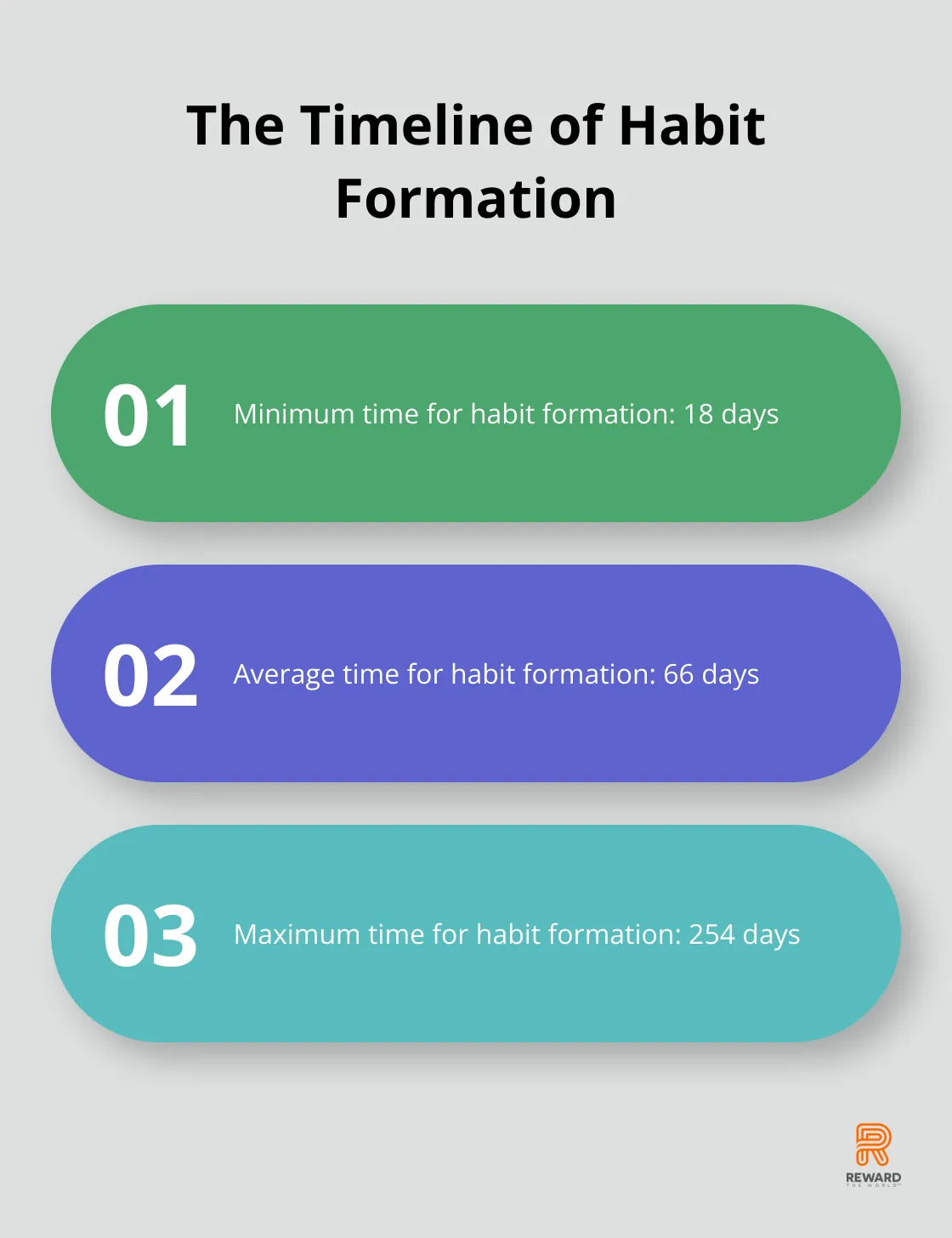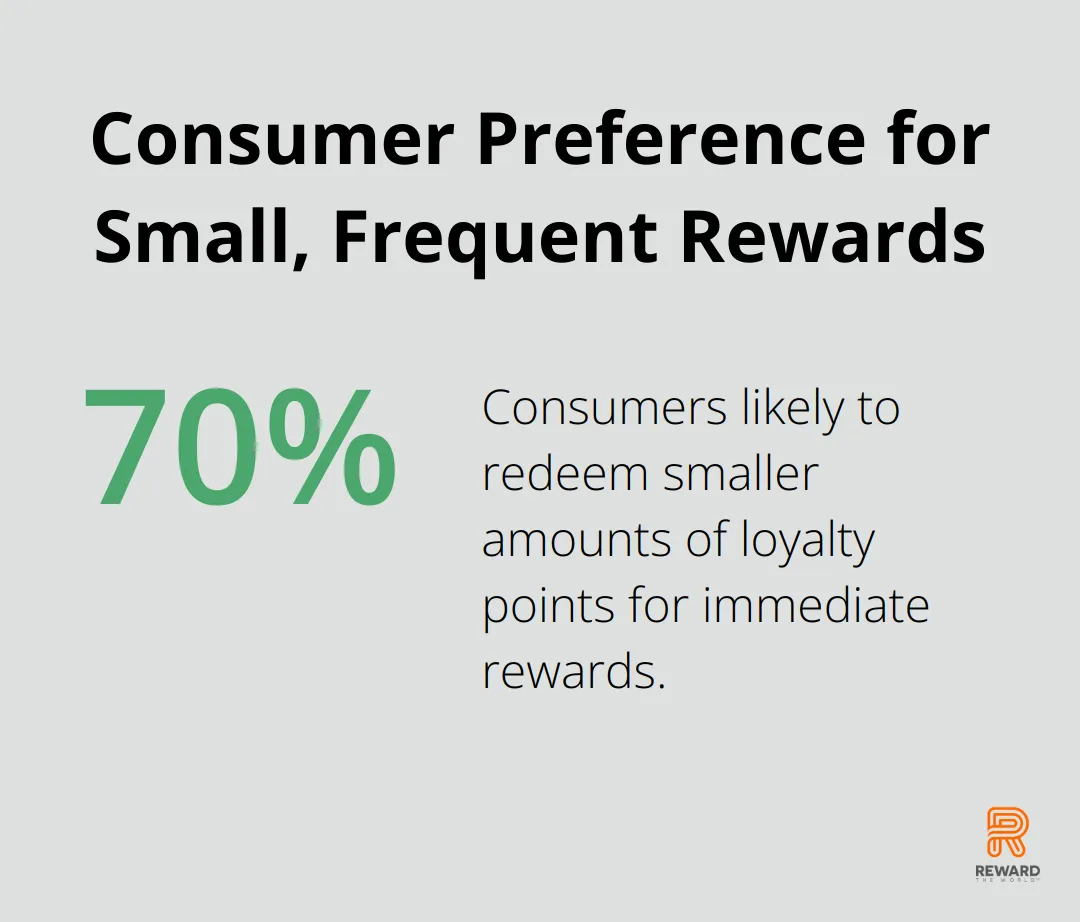
At Reward the World, we’ve seen how integrating rewards into daily customer habits can transform loyalty programs. The rise of mobile wallets has made it easier than ever to seamlessly blend rewards into everyday transactions.
But how can businesses effectively harness the power of habit formation to boost customer engagement? This blog post explores strategies for creating sticky reward programs that become an integral part of your customers’ routines.
How Habits Shape Customer Loyalty
The Science of Habit Formation
Research indicates that habits can develop in a range of 18 to 254 days, with an average of about 66 days. This knowledge proves invaluable for businesses that want to integrate rewards into their customers’ daily routines. Companies can help customers form positive habits associated with their brand through consistent rewards for specific actions over this period.

The Anatomy of Habits
Habits consist of three components: cue, routine, and reward. A coffee shop might use a mobile app notification (cue) to prompt a customer to make a purchase (routine), then offer points or a discount (reward). This cycle, when repeated, can transform occasional buyers into loyal, habitual customers.
The Power of Rewards in Habit Reinforcement
Rewards act as a critical component in habit formation by providing positive reinforcement. A study by the Journal of Consumer Research found that immediate rewards are twice as effective as delayed gratification in forming lasting habits. This explains why instant gratification features are so powerful in shaping customer behavior.
Companies can harness this by offering micro-rewards for small, frequent actions. For instance, a fitness app might award points for daily check-ins, gradually building a habit of regular engagement. These small rewards can lead to significant changes in customer behavior and loyalty over time.
Personalization: The Key to Effective Habit Loops
Habit formation isn’t a one-size-fits-all approach. Personalization plays a crucial role in creating effective habit loops. Data from Epsilon reveals that 80% of consumers are more likely to make a purchase when brands offer personalized experiences.
Companies can tailor rewards to individual preferences and behaviors through customer data analysis. This might involve offering a free coffee to a morning person or late-night shopping discounts to a night owl. The more relevant the reward, the stronger the habit-forming potential.
Technology as a Habit-Forming Tool
The rise of mobile wallets has made it easier than ever to seamlessly blend rewards into everyday transactions. Companies can now create digital touchpoints that integrate seamlessly into customers’ daily lives, making habit formation more natural and effortless.
For example, Reward the World’s platform allows businesses to deliver instant rewards across various categories, making it simple to reinforce positive habits at the moment of action. This immediacy is key to creating strong, lasting habits that drive customer loyalty.
As we move forward, let’s explore how businesses can design reward programs that stick, leveraging these insights into habit formation and customer behavior.
How to Create Sticky Reward Programs
Seamless Integration into Daily Life
Sticky reward programs require a deep understanding of customer behavior and strategic implementation. Programs that integrate seamlessly into customers’ daily routines see significantly higher active participation rates. Identifying customer behavior patterns and predicting future behavior allows businesses to adjust their product offerings and marketing strategies accordingly.
A coffee shop chain could integrate its rewards program with a mobile payment system. Customers automatically earn points every time they pay for their morning coffee using their phone. This frictionless experience encourages repeat visits and solidifies the habit of choosing that particular coffee shop.
Leveraging Technology for Instant Gratification
In today’s fast-paced world, instant gratification plays a crucial role. Nearly 70% of consumers are likely to redeem smaller amounts of loyalty program points in exchange for rewards like the chance to win a prize or a customized experience. Technology enables businesses to meet this demand effectively.

Mobile apps with push notifications can alert customers to available rewards in real-time. A grocery store app could send a notification about a personalized discount right as the customer enters the store. This timely reminder increases the likelihood of a purchase and reinforces the value of the loyalty program.
Personalization: The Game-Changer
One-size-fits-all approaches no longer suffice in today’s market. Recent research shows that 74% of consumers abandoned their shopping baskets in the last three months simply because they felt bombarded by content, overwhelmed by choice, and unable to make a decision. This statistic underscores the importance of data-driven personalization in reward programs.
A clothing retailer could use purchase history and browsing behavior to offer tailored rewards. For example, a customer who frequently buys athletic wear could receive exclusive early access to new sportswear collections or fitness-related perks. This level of personalization makes the rewards feel more valuable and relevant, increasing the program’s stickiness.
Scalability and Flexibility
Implementing these strategies requires a robust platform capable of real-time data processing and reward delivery. The ideal platform should offer scalability and flexibility to accommodate businesses of all sizes and industries. (Reward the World stands out in this aspect, with its ability to instantly deliver rewards across multiple categories to a vast user base of 250 million.)
Measuring and Optimizing Program Performance
To ensure the continued success of a sticky reward program, businesses must consistently measure and optimize its performance. Key metrics to track include engagement rates, redemption rates, and customer lifetime value. (Regular analysis of these metrics allows companies to refine their reward strategies and maximize the program’s effectiveness.)
As we move forward, let’s explore how businesses can measure the impact of their habit-based reward programs and calculate the return on investment for these initiatives.
How to Measure the Impact of Habit-Based Reward Programs
Key Performance Indicators for Habit Formation
Businesses must focus on specific metrics to indicate habit formation and program engagement. These include:
- Engagement frequency: Monitor customer interactions with your program. Daily active users (DAU) and monthly active users (MAU) provide valuable insights.
- Behavior consistency: Track the regularity of customer actions. For a fitness app, measure the percentage of users who log workouts at least three times a week.
- Habit formation time: Calculate how long new users take to become regular participants. UniSA researchers found that new habits can begin forming within about two months (median of 59-66 days) but can take up to 335 days to establish.
- Reward redemption rate: A high redemption rate often correlates with program satisfaction and habit strength. Bond Brand Loyalty reports that 79% of consumers consider reward redemption a highly valued aspect of loyalty programs.

Customer Engagement and Retention Analysis
To understand the true impact of habit-based rewards, businesses should examine:
- Customer Lifetime Value (CLV): Compare the CLV of program participants versus non-participants. Members of loyalty programs generate 12-18% more incremental revenue growth per year than non-members.
- Net Promoter Score (NPS): Measure customer likelihood to recommend your brand. Habit-forming reward programs often lead to higher NPS scores.
- Churn rate: Monitor how your rewards program affects customer retention. Effective programs can reduce churn by up to 30%.
- Purchase frequency and average order value: Analyze how your program influences buying behavior. (Starbucks Rewards members visit stores 2-3 times more frequently than non-members.)
ROI Calculation for Habit-Integrated Rewards
To justify investment in habit-based reward programs, demonstrate a positive return on investment (ROI):
- Direct revenue impact: Calculate additional revenue generated by program members compared to non-members. Subtract program costs to determine net impact.
- Cost savings: Measure reduced marketing costs due to increased customer retention and word-of-mouth referrals. Acquiring a new customer can cost five to seven times more than retaining an old one.
- Indirect benefits: Consider improvements in brand perception, customer satisfaction, and market share. While harder to quantify, these factors contribute significantly to long-term success.
- Incremental lift: Use A/B testing to compare the performance of customers exposed to your habit-based rewards versus a control group.
Data-Driven Optimization
This data-driven approach allows for continuous optimization. Businesses can refine their reward strategies and maximize program effectiveness by regularly analyzing these metrics. Platforms like Reward the World offer robust analytics capabilities, enabling businesses to track and improve their habit-based reward programs effectively.
Final Thoughts
Integrating rewards into daily customer habits has become a powerful strategy for businesses to enhance loyalty and drive long-term engagement. Companies can create sticky reward programs that become an integral part of their customers’ routines by leveraging the science of habit formation and tapping into the psychology of immediate gratification. The future of customer loyalty lies in seamless, personalized experiences that blend effortlessly into daily life through mobile wallets and other digital platforms.
We anticipate a growing trend towards hyper-personalized rewards, delivered in real-time. As technology evolves, we expect to see more sophisticated use of AI and machine learning to predict and influence customer behavior, creating even more effective habit-forming reward strategies. For businesses looking to implement these strategies, it’s important to identify specific behaviors to encourage and design rewards that provide immediate, tangible value.
At Reward the World, we’ve witnessed how effective habit-based reward programs can transform customer engagement and drive business growth. Our platform offers instant reward delivery across multiple categories, making it simple for businesses to reinforce positive habits at the moment of action. (With availability in 15 languages, we provide a scalable solution for businesses looking to implement powerful, habit-forming reward strategies.)
